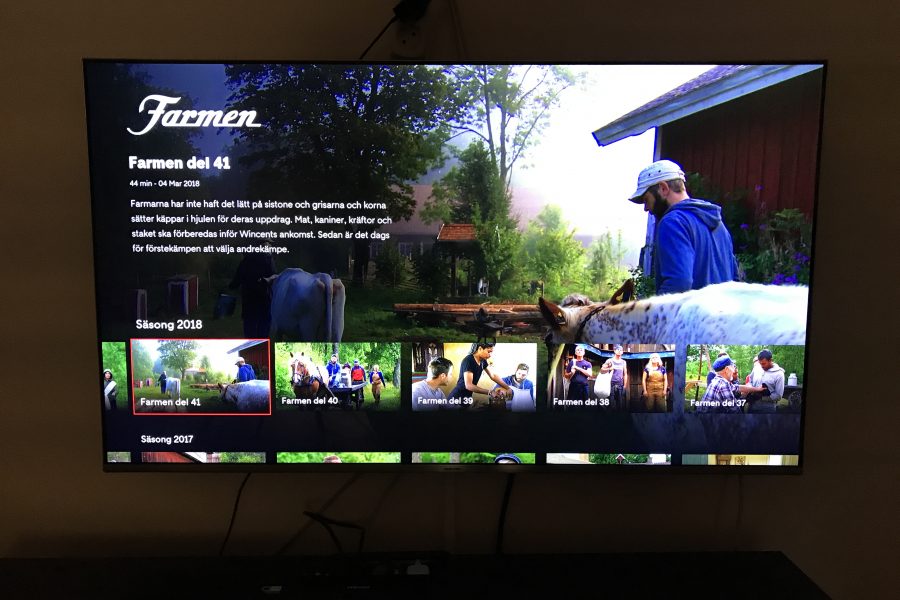Bonnier broadcasting is part of Bonnier Group, the second largest media company in Sweden (after Spotify, with regards to yearly revenue). Bonnier broadcasting owns TV4 — the largest private TV channel in Sweden, and C More — the fastest growing Netflix competitor on the Swedish market. Being a company with the traditions of broadcast TV, it now faces the challenges of digital transformation. With the goal of making it easier and more attractive to our users that still have a regular TV at home we were assigned the task to design and develop an app for our AVOD-service TV4 Play on Samsung Smart TV.
Product available at
TV4 Play app for Samsung Smart TV’s 2015 and later, in Sweden
Team
- Project manager
- Lead UX designer (me)
- Visual designer
- Supportive UX designer x 2
- System architect
- Developers and testers (out-sourced)
Approach
Together with the project manager I set up a plan for how to work towards the initial deadline. Because of slow discussions amongst the legal departments for out-sourcing this deadline changed many times over the project. Because of our agile design-approach we were able to always adapt to the new circumstances. Our final approach turned out as follows:
- Contextual inquiry with TV users.TV users was a new target group for me to work with, so I started by interviewing TV users and observing them while use some existing TV apps. This initial set of interviews laid the fundament to another project that a colleague of mine lead to get a more thorough understanding of what drives people to watch TV.
- Fast iterative design of prototypes that were constantly tested with users.Because this was a new platform for the company, there were no prototypes we could just take and quickly adapt. There was also the challenge of finding a way to properly test the user experience of navigating with a TV remote, without the possibility of quickly pushing out new versions of an actual test version to run on a TV. I ended up setting up a prototype in Axure, that I could have the user control with an XBOX controller. This is not the exact same feeling as holding a remote, but it offers the same limited navigational buttons. It turned out that this setup worked really well, even for users that were not in the habit of using game console controls.
- Constant dialogue with project manager and service owner.In order to make sure that all business requirements were met I constantly discussed the prototype and the results of the test with users with the project manager and the service owner.
- Detailing the visual design.Already from the start I worked closely with the visual designer to make sure that we are working towards the same vision. We discussed the details of spacing, gradients and animations. As soon as we had a contract with the out-sourced development and testing, we involved them in our discussions.
- Specifying the MVP.For legal reasons, it was necessary to specify the Minimum Viable Product in text. Because we had already came a long way with the prototype, this was fairly easy.
- Frequent dialogue with developers.Once the developers stared working we had many discussions with them about alternative solutions, misunderstandings in our requirements and details in the design.
- Testing the demo version with users.At the end of each sprint we received a demo version that we tested and gave feedback on. We tested the demo with users as soon as it was working well enough.
- Testing the live version with users.Once released we included the app in our recurring tests with users to always be open to finding new issues with the user experience.
Personal learnings
This project was really fun because it was the first project at Bonnier Broadcasting for me to do from concept to release. It reminded me of the limits that are set because of legal issues. I managed to see this as an exciting challenge, which in turned made me navigate around many of the obstacles to keep up the tempo in the project.
It was really fun for me to work out how to create a prototype that would feel like using a real TV-app. This posed the challenges of using a remote rather than a mouse or a touch screen, as well as making video play in the prototypes. There are many prototyping tools in the UX industry, but none of them have good support for including video. In the end I managed to find a fairly good level of detail, that gave the users quite a good feeling and at the same time was not too cumbersome to change. Thus, we could work fast and perform many iterations from one week to another.
Lastly, I was reminded how fun it is to work in a small, close team. Most of the work was performed by me, the project manager and the visual designer. We ended up being a very tight team, that worked efficiently together, and whenever needed we were able to include other people that would bring the project forward at that given time.



